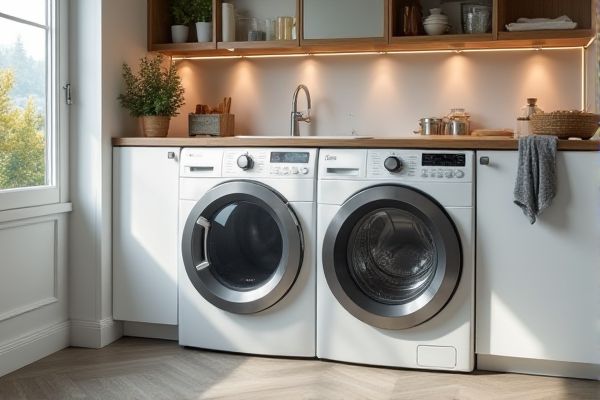
Undercounter washers save space by fitting seamlessly beneath countertops, making them ideal for compact areas, while standalone washers offer greater capacity and flexibility but require designated floor space. Explore this article to determine which option best suits your laundry needs and home setup.
Table of Comparison
| Feature | Undercounter Washer | Standalone Washer |
|---|---|---|
| Size | Compact, fits under counters (usually 24" wide) | Larger footprint, requires designated space |
| Installation | Built-in, flush with cabinetry | Freestanding, flexible placement |
| Capacity | Smaller load capacity (2-3 cubic feet) | Larger capacity (up to 5+ cubic feet) |
| Mobility | Generally fixed, difficult to move | Easily movable |
| Design Aesthetics | Flush, sleek, integrated look | Standalone design, varies by model |
| Price Range | Typically higher due to compact design | Varies widely, often more affordable |
| Typical Use | Small spaces, apartments, condos | Standard homes, laundry rooms |
| Water Efficiency | Typically water-efficient due to size | Varies by model, many Energy Star options |
Introduction: Undercounter Washer vs Standalone Washer
Undercounter washers are designed to fit seamlessly beneath kitchen or utility room countertops, optimizing space in compact areas. Standalone washers offer greater capacity and flexibility in placement, often including advanced features and larger drum sizes. Choosing between the two depends on your spatial constraints, laundry volume, and installation preferences.
Key Differences Between Undercounter and Standalone Washers
Undercounter washers are compact appliances designed to fit seamlessly beneath countertops, ideal for small spaces and providing a sleek, integrated look, while standalone washers are larger units offering higher capacity and more robust features suitable for extensive laundry needs. The key differences include installation flexibility, with undercounter models requiring specific cabinetry and plumbing setups, whereas standalone washers offer easier placement and mobility. Energy efficiency and water usage can vary, so choosing the right washer depends on your space constraints and laundry volume requirements.
Space Efficiency and Installation Requirements
Undercounter washers offer superior space efficiency by fitting seamlessly beneath countertops, making them ideal for small kitchens or compact laundry rooms. Their installation requires precise measurements and plumbing adjustments to accommodate the integrated design, often necessitating professional setup. Standalone washers, while more flexible in placement, demand dedicated floor space and simpler installation that can accommodate various locations without integration constraints.
Capacity and Load Size Comparison
Undercounter washers typically offer a capacity ranging from 1.5 to 3.5 cubic feet, suitable for small to medium loads, making them ideal for compact living spaces or single users. Standalone washers generally provide larger capacities, between 3.5 and 5.0 cubic feet, accommodating bigger loads and family-sized laundry batches more efficiently. Choosing between these washers depends on the frequency of laundry and the typical size of wash loads, with standalone models better suited for heavy or bulky items.
Performance and Washing Technology
Undercounter washers utilize space-efficient designs with advanced wash cycles tailored for compact loads, often featuring precise temperature controls and shorter cycle times that maintain performance despite size constraints. Standalone washers generally offer larger capacities and robust motor systems, delivering powerful agitation and enhanced stain removal through varied wash programs driven by cutting-edge technology such as steam cleaning or smart sensors. Your choice depends on balancing performance needs with available space, as standalone models excel in heavy-duty washing while undercounter washers optimize efficiency in smaller areas.
Energy and Water Consumption
Undercounter washers typically consume less water and energy due to their smaller size and efficient design, making them ideal for compact living spaces. Standalone washers often have larger capacities, resulting in higher energy and water usage per load but better for bigger households with frequent laundry needs. Energy Star-rated models in both categories can significantly reduce utility bills by optimizing power and water consumption.
Design Aesthetics and Customization
Undercounter washers offer a sleek, integrated look that seamlessly fits beneath countertops, enhancing kitchen or laundry room design aesthetics with a minimalist profile. Standalone washers provide greater flexibility in placement and often come in a variety of finishes and sizes, allowing homeowners to customize their laundry setup to suit different spaces and styles. Choosing between undercounter and standalone washers depends on balancing streamlined design integration with the need for adaptability and visual variety.
Cost Considerations and Value for Money
Undercounter washers typically have a higher upfront cost due to their compact design and integration features, but they save space and provide convenience in small living areas. Standalone washers are generally more affordable with greater capacity, offering better value for money in households requiring frequent or larger loads. Evaluating long-term energy efficiency and maintenance expenses is crucial for maximizing cost-effectiveness in both appliance types.
Maintenance and Longevity
Undercounter washers require regular maintenance due to their compact design, which can lead to tighter spaces for ventilation and potential buildup of moisture, affecting longevity. Standalone washers typically offer easier access for cleaning and repairs, contributing to better long-term performance. Understanding these differences helps you choose a washer that aligns with your maintenance preferences and ensures lasting durability.
Choosing the Right Washer: Which Is Best for Your Home?
Undercounter washers save valuable space by fitting seamlessly beneath countertops, making them ideal for compact kitchens or laundry areas, while standalone washers offer larger capacity and flexibility in placement. Your choice depends on available space, laundry volume, and installation preferences, with undercounter models providing a sleek, integrated look and standalone units delivering more power for heavy-duty washing. Consider the size of your household and the frequency of use to determine which washer type best meets your home's needs.
 homyna.com
homyna.com